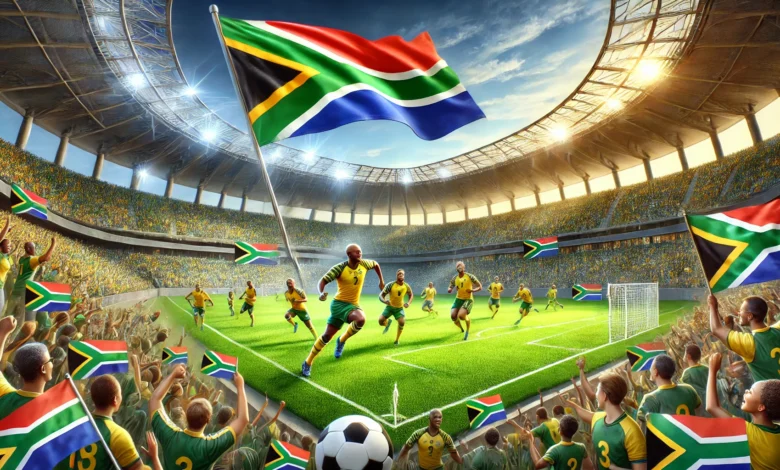The Rise, Challenges, and Legacy of Bafana Bafana

Introduction
Bafana Bafana, South Africa’s national soccer team, is more than just a sports entity—it symbolizes hope, unity, and resilience in a nation with a complex history. Since their first official match in 1992, after South Africa’s readmission to international football, Bafana has inspired millions. The team has become a beacon of national pride, embodying the spirit of a country striving for progress and unity. Their story is one of triumphs, setbacks, and enduring hope, reflecting the nation’s journey.
In this article, we explore Bafana Bafana’s rich history, delving into their early successes, challenges, cultural significance, and ongoing efforts to reclaim their position among football’s elite. From their golden years to their current standing, Bafana Bafana’s journey offers lessons not only for South African football but also for the broader global community.
The Origins and Early Years of Bafana Bafana
Bafana Bafana emerged onto the international stage at a pivotal moment in South Africa’s history. With the end of apartheid in the early 1990s, South Africa was readmitted to international sports, and the national football team played their first official match against Cameroon in July 1992. The victory in that debut match signalled a promising start for the team and a new era for South African football.
One of the most significant achievements in their early years was winning the African Cup of Nations (AFCON) in 1996. Hosted on home soil, the tournament became a defining moment for Bafana Bafana and South Africa as a nation. Led by legendary players like Lucas Radebe, Mark Fish, and Phil Masinga, the team captivated the hearts of millions with their skill, determination, and unity. Their victory symbolized the possibility of a brighter, more inclusive future for the country.
However, the team’s early years were not without challenges. Limited infrastructure, insufficient grassroots programs, and the lingering effects of apartheid’s exclusionary policies meant that the foundations of South African football were shaky. Despite these hurdles, Bafana’s success in the 1990s laid the groundwork for what many hoped would be a golden era.
Golden Years and Decline
The late 1990s and early 2000s marked a mix of success and growing challenges for Bafana Bafana. The team qualified for its first FIFA World Cup in 1998, held in France, and followed it up with another qualification in 2002. These milestones solidified South Africa’s presence on the global football stage and demonstrated the team’s potential.
However, cracks began to emerge in the years following these successes. The team’s performances in continental competitions started to decline, and they failed to progress past the group stages in several tournaments. A lack of consistent leadership became a significant issue, with frequent changes in coaching staff disrupting the team’s development. Additionally, as other African nations invested heavily in their football programs, Bafana Bafana struggled to keep pace.
Systemic issues within South African football further compounded the decline. The absence of robust youth development structures and financial mismanagement left the team unable to compete with emerging powerhouses like Nigeria, Ivory Coast, and Ghana. By the mid-2000s, Bafana Bafana’s fall from grace was evident, with the team failing to qualify for several major tournaments.
Revival Efforts and Modern-Day Challenges
The 2010 FIFA World Cup offered hope for South African football. As the first African nation to host the prestigious tournament, South Africa had a unique opportunity to showcase its passion for the sport. Bafana Bafana’s opening match against Mexico featured one of the most iconic moments in the team’s history: Siphiwe Tshabalala’s stunning goal that electrified the nation. Although the team failed to progress beyond the group stage, their spirited performances reignited national pride.
In the years following the World Cup, efforts to revive Bafana Bafana’s fortunes gained momentum. The South African Football Association (SAFA) introduced grassroots development programs and established youth academies to nurture local talent. Promising players emerged, offering hope for a brighter future. However, challenges persisted. Financial constraints, administrative inefficiencies, and limited investment in local leagues hindered the team’s progress.
Today, Bafana Bafana’s standing in African and global football remains modest. While they have shown flashes of brilliance, consistency remains elusive. To reclaim their former glory, the team must address systemic issues, invest in long-term development, and foster a culture of excellence.
Cultural and Social Impact of Bafana Bafana

Beyond the pitch, Bafana Bafana holds immense cultural and social significance for South Africa. The team’s successes and struggles have mirrored the nation’s journey, symbolizing resilience and unity. During the 1996 AFCON, their victory brought together a country still grappling with the wounds of apartheid. Football became a unifying force, transcending racial and social barriers.
Bafana Bafana’s influence extends beyond national borders. The team has inspired countless young players in South Africa and across the continent to pursue their dreams. Their legacy underscores the power of sports to inspire, uplift, and bring people together.
However, the team’s cultural impact also highlights the importance of sustained success. As the nation’s most prominent football representative, Bafana carries the weight of national expectations. Their performances have the potential to inspire new generations or, conversely, to dampen enthusiasm for the sport.
Conclusion
Bafana Bafana’s journey is a testament to the resilience of South Africa and its people. From their triumphant beginnings in the 1990s to the challenges of recent years, the team has shown that success requires not only talent but also vision, investment, and unwavering commitment.
As South Africa continues to rebuild its football infrastructure, the hope remains that Bafana Bafana will again rise to global prominence. Their story serves as a reminder that setbacks are not the end of sports and life—they are opportunities for growth and renewal.
FAQs
1. Why is the team called Bafana Bafana?
“Bafana Bafana” means “The Boys, The Boys” in Zulu. It reflects the team’s youthful energy and spirit.
2. What was Bafana Bafana’s most significant achievement?
Their most significant achievement was winning the 1996 African Cup of Nations, a moment that united the nation and showcased their potential.
3. Why did Bafana Bafana struggle after the 1996 AFCON win?
Management instability, lack of investment in youth development, and increasing competition from other African nations contributed to their decline.
4. How did the 2010 FIFA World Cup impact South African football?
Hosting the World Cup boosted national pride, improved infrastructure, and highlighted the potential of South African football.
5. How can Bafana Bafana return to its glory days?
Investing in grassroots programs, strengthening local leagues, and fostering consistent leadership are key to their revival.





